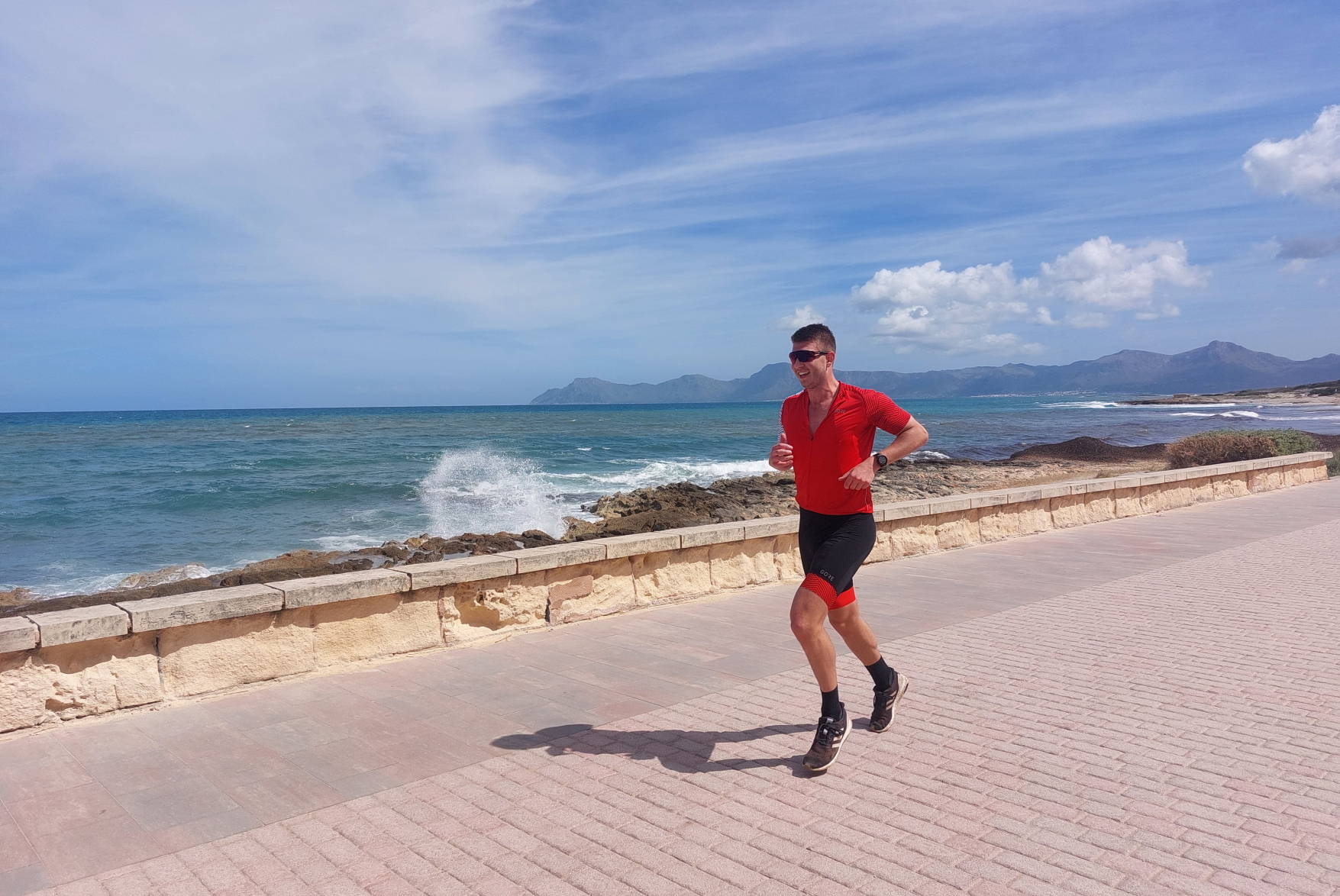Die ersten Sonnenstrahlen läuten den Übergang von der Grundlagenphase (BASE) in die Aufbauphase (BUILD) ein. Ziel des Aufbautrainings ist die Entwicklung eines möglichst hohen Ausdauerniveaus und Vorbereitung des Körpers auf die späteren intensiven Wettkampfbelastungen. Für das Training bedeutet das den Anstieg der Trainingsbelastung in Bezug auf Umfang und Intensität.
In den vergangenen Wochen haben wir eine gewisse Belastungsverträglichkeit aufgebaut und in den Bereichen Ausdauer, Schnelligkeit sowie Kraft ein Grundniveau geschaffen, auf dem sich aufbauen lässt. Jetzt werden gezielte Schwerpunkte gesetzt damit sich die Leistungsfähigkeit in die richtige Richtung entwickelt. In welchen Bereichen die Schwerpunkte gesetzt werden, hängt von den Zielen und der Ausgangslage ab.
Grundsätze für das Aufbautraining - das solltest Du beachten
Zentrales Element des Aufbautrainings ist zunächst die Steigerung der Trainingsumfänge. Darüber hinaus werden nun in den Einzeldisziplinen zunehmend spezifischere Trainingsreize gesetzt. Dabei gilt es ein paar grundsätzliche Dinge zu beachten:
Der Übergang in die neue Trainingsphase stellt keinen harten Bruch zum vorangegangenen Training dar. Man trainiert nicht von einer Woche zur anderen deutlich mehr und deutlich härter. Der Übergang sollte fliessend gestaltet werden. Grundsatz: erst Umfang, dann Intensität.
Die Trainingsumfänge solltest Du schrittweise zu steigern, um keine Überlastungsfolgen zu riskieren. Darüber hinaus ist es sehr wichtig, für die folgende Aufbauphase seine Trainingsbereiche zu definieren, um die gewünschten Anpassungen zu erzielen. Zur genauen Ermittlung bzw. Anpassung der Trainingsbereiche, ist eine Leistungsdiagnostik jetzt sehr sinnvoll.
Trotz der spezifischeren Einheiten, die zunehmend in den Trainingsplan integriert werden, findet das Training weiterhin zu großen Teilen im aeroben Grundlagenbereich statt. Neben allgemein gesteigerten Umfängen sollte die Build-Phase bei fortgeschrittenen Athleten auch zur Ausprägung unterschiedlicher Schwerpunkte genutzt werden. Dies können zunächst disziplinspezifische Schwerpunktsetzungen sein, z.B. wöchentliche Schwerpunkte bzw. Trainingsblöcke in den Einzeldisziplinen Schwimmen, Radfahren, Laufen.
Dabei wird pro Woche oder pro Trainingsblock eine Disziplin durch Anzahl und Umfänge der Trainingseinheiten besonders hervorgehoben, um hier einen deutlichen Leistungszuwachs zu erreichen. Das Training in den anderen Disziplinen findet in reduziertem Maß statt (geringere Anzahl der Trainingseinheiten).
Zusätzlich werden die Inhalte der Trainingseinheiten nun zunehmend spezifischer auf die Erfordernisse des Wettkampfs und das individuelle Handlungspotenzial ausgerichtet.
Mögliche Handlungsfelder können sein: Steigerung der VO2max, Senkung der Laktatbildungsrate sowie Verbesserung der Kraftausdauer oder der Schnelligkeit. Welche dieser Schwerpunkte in der Build-Phase im Fokus stehen sollten, ist davon abhängig was man genau verbessern möchte. Man sollte sich fragen: Auf welche Distanz bereite ich mich vor? Wo stehe ich? Was brauche ich, um am Wettkampftag erfolgreich zu sein? Wo liegen demzufolge meine größten Potenziale, auf die ich meinen Fokus legen sollte? Im Folgenden gehen wir auf verschiedene Schwerpunkte genauer ein.
VO2max Training vs. Senkung Laktatbildungsrate
Welche Trainingsinhalte für die Wettkampfperformance am relevantesten sind, hängt vor allem von der Wettkampfdistanz ab. Liegt Dein Wettkampfziel auf der Sprint- oder Olympischen Distanz, geht es in der Build-Phase eher darum, die VO2max und Schnelligkeit zu steigern. Wie das geht, liest Du weiter unten.
Für Mittel- und Langdistanz-Athleten stehen vermehrt Trainingsinhalte zur Senkung der Laktatbildungsrate, Verbesserung aeroben Stoffwechsels und Kraftausdauer auf dem Programm. Gezielte VO2max Programme stehen in Ergänzung ebenso auf dem Plan, bilden allerdings nicht den Schwerpunkt. Welche Trainingsinhalte dafür geeignet sind, liest Du weiter unten.
Tri-Wissen Laktatbildungsrate: Das Wettkampftempo auf Mittel- und Langdistanzen findet im Bereich der erweiterten oder intensiven Grundlagenausdauer, also deutlich unterhalb der anaeroben Schwelle statt. In diesem Intensitätsbereich werden vor allem Kohlenhydrate verstoffwechselt, vorrangig aerob, jedoch unter beginnender anaerober Glykolyse. Trainingsziel ist es daher, die Laktatproduktion für diese spezifische Intensität so weit wie möglich zu senken, d.h. die gleiche Geschwindigkeit mit weniger anaerober Stoffwechselaktivität zu bewältigen.
Steigerung VO2max und Grundgeschwindigkeit
Um die VO2max in der Build-Phase zu steigern, ist es sinnvoll, polarisiert zu trainieren. Das heißt man realisiert gewisse Umfänge im GA-Bereich und streut regelmäßig hochintensive Intervalleinheiten ein.
Zudem bietet sich hierzu die Block-Periodisierung an. Beispiel: im Trainingszyklus gibt es eine Intensitätswoche mit 3-5 (hoch)intensiven Einheiten. Die jeweils folgenden drei Wochen sind Grundlagenwochen mit nur einer hochintensiven Einheit, ansonsten nur im GA-Bereich.
Hochintensive Einheiten zeichnen sich auch dadurch aus, dass sie durch hohe Geschwindigkeiten bzw. Leistungen hohe Kraft- und Technik- bzw. Motorik-Anforderungen stellen. Das führt dazu, dass sich auch die neuronale Ansteuerung und z.B. die Lauftechnik verbessern. Letztendlich verbessert sich also die Schnelligkeit, die gerade auf kürzeren Distanzen eine wichtige Rolle spielt.
Spezifische Einheiten:
- Schwimmen: 50-100m-Intervalle
- Radfahren: 30s-1min-Intervalle im Spitzenbereich (z.B. 3x8x30/30s), 3-8min-Intervalle im Entwicklungsbereich (z.B. 4x4min)
- Laufen: 200-400m-Intervalle im Spitzenbereich (z.B. 2x8x300m), 800m-2000m-Intervalle im Entwicklungsbereich (z.B. 6x1000m)
Senkung Laktatbildungsrate, Kraftausdauer, erweiterte aerobe Grundlage
Je länger die Wettkampfdistanz, desto wichtiger wird die erweiterte Grundlagenausdauer, die dem Aufbau der wettkampfspezifischen Geschwindigkeit dient. Eine erweiterte Grundlage entwickelt man durch Intervalle im GA2- bzw. Sweetspot-Bereich. Zur Verbesserung der Kraftausdauer erhöht man in diesem Bereich zusätzlich den Kraftanteil, indem man beim Schwimmen Paddles anzieht und beim Radfahren die Trittfrequenz gezielt verringert. Ziel dieser Einheiten ist es vor allem, die Laktatbildungsrate zu senken, d.h. den Kohlenhydratverbrauch in der Wettkampfintensität zu verringern.
Spezifische Einheiten:
- Schwimmen: Intervalle mit Paddles
- Radfahren: K3-Intervalle im Sweetspot-Bereich mit niedriger Trittfrequenz (ca. 50-70) am Berg (z.B. 3x8min)
- Laufen: Tempowechselläufe bzw. längere Intervalle im Sweetspot-Bereich (z.B. 3x3km)
Tipp: Ab ins Trainingslager
Ein Trainingslager im März/April warmen Süden ist ein effektiver Trainingsblock, vor allem für das Radfahren. Vorteile bringt hier nicht nur das gute Wetter, sondern auch das gesamte Umfeld und die Trainingsumstände. Der Mehrwert ergibt sich aus dem deutlich erhöhten Trainingspensum und der Möglichkeit optimaler Regeneration. Trainieren-Essen-Schlafen. Den Alltagsstress hinter sich lassen. In dieser Kombination ein richtiger Kick für die Leistungsfähigkeit.
Fazit
In der Build-Phase kommt es darauf an, gezielte Schwerpunkte zu setzen. Es geht darum, sich entsprechend der spezifischen Wettkampfanforderungen in die richtige Richtung zu entwickeln. Dazu setzt man gezielte Intensitäten und steigert die Umfänge, wobei der Großteil des Trainings, wie in der Base-Phase, aus Grundlagen-Einheiten besteht.




















